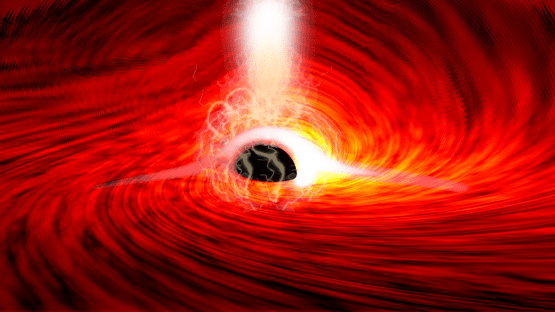Astrophysicists at Stanford and other research institutions around the globe announced the discovery of detectable light coming from a black hole approximately 800 million light years from Earth, in a paper published on Jul. 28.
The finding presented proof that agrees with scientist and mathematician Albert Einstein’s theory of relativity, which initially predicted the phenomenon of light bending around massive objects.
“Seeing light from behind the black hole — we’ve kind of suspected it should be there,” lead researcher and Stanford astrophysicist Dan Wilkins said.
Light from black holes is formed when gas disks fall into the black hole, creating a corona which in turn creates X-ray flares — bright light which emanates from the black hole. Light from the X-rays bounces off the gas disk and forms light echoes which bend around the black hole due to the hole’s gravitational force.
“The X-ray light does not come from the black hole itself, but from hot gas/plasma in orbit around it (the accretion disk),” William Brandt, a researcher on the study and physics professor at Pennsylvania State University, wrote in a statement to The Daily.
With the aid of general relativity, these light echoes will be helpful in discovering more about black holes, Brandt added.
Wilkins and fellow astrophysicists never expected to pick up detectable traces of light from behind black holes.
“Up until now, we’ve just assumed that we wouldn’t be able to pick out that light,” Wilkins said. “It would be lost in everything else that’s going on, because there’s all of the light that’s coming from all of the gas that’s around the black hole.”
Roger Blandford — a professor of physics, particle physics and astrophysics who has been performing physics-related research for over 50 years — is optimistic that researchers have achieved a better understanding of the functions revolving around black holes, and believes that this discovery is significant to the field of astrophysics.
“It is always good to provide more checks of a successful theory.” Blanford wrote.
Wilkins explained that the X-ray echoes are only one part of the story that makes up black holes. He said the researchers are hoping to learn exactly what is happening to the gas as it falls into the black hole “because we really want to learn about how the gas falling into the black hole is able to power such a bright light source.” He added that, as the gas falls into these supermassive black holes, it creates the most bright continuous source of light in the known universe.
According to Wilkins, before the discovery of the light from black holes, he and his team had noticed the strange echoes of the X-ray flares.
“We do more and more tests to make sure that what we’re looking at is real — that this really is the best interpretation for what we’re seeing,” Wilkins said. “But then once it sort of starts to crystallize that we’re really seeing the signal of light coming from behind the black hole — that’s really quite exciting.”
The study was not always easy to conduct. COVID-19 made communication slower — the researchers had to work from home, away from their labs, starting in Jan. 2020, according to Wilkins. The five researchers who authored the study were scattered across the world as the pandemic took hold — living in the United States, the Netherlands and Canada, while data on the black hole was being received and uploaded from the European Space Agency’s XMM-Newton and NASA’s NuStar telescopes.
Researchers worked at Stanford University, Pennsylvania State University, Kavli Institute for Particle Astrophysics and Cosmology, Netherlands Institute for Space Research, the University of Amsterdam and Saint Mary’s University.
“I think, particularly when we’re working with colleagues around the world, everybody’s had a lot going on with COVID. Everyone’s personal circumstances are different, so it has meant that we need to be very mindful of what people have got going on — and it means people don’t necessarily reply as quickly as they used to,” Wilkins said.
The research will not stop with this study. Athena (Advanced Telescope for High-ENergy Astrophysics), the European project, will also be studying black holes. Wilkins said the mirror in this telescope is bigger, meaning it will be able to collect more light and produce a more detailed picture.
“It is a 3-billion-euro project, so you can imagine that involves a lot of people from all around the world,” Wilkins said.
